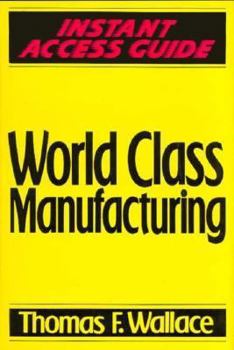Instant Access Guide: To World Class Manufacturing
Each chapter in this accessible resource delivers essential information in five minutes or less. By scanning through the Overview, Key Ideas, Problems and Solutions and Management/Implementation issues, readers can rapidly perceive new ideas and advice which can be immediately applied to their situation. Approximately 40 international experts discuss such topics as product development, performance measurement, continuous improvement and quality, manufacturing and building loyal workforces.
Format:Hardcover
Language:English
ISBN:0471131822
ISBN13:9780471131823
Release Date:September 1994
Publisher:Wiley
Length:496 Pages
Weight:1.85 lbs.
Dimensions:9.3" x 1.5" x 6.4"
Customer Reviews
1 rating
Very good snapshot of 1994
Published by Thriftbooks.com User , 20 years ago
This book is basically about all of the buzzwords or TLA's (Three Letter Acronyms) of 1994. I found it a very fascinating book. This book is a compilation of about fourty different authors, each of which write a different chapter on a different aspect of manufacturing. A lot of the chapters focus on the buzzwords of the time, like JIT, TQM, QFD, ISO 9000, and SQM. I found it really interesting to see what had changed and what had stayed the same. I have the following observations: 1) That all of the government based programs (ISO, Malcom Baldridge awards) are still around, 2) That everything that has a pattented, proprietary chart or graph is gone (QFD, NewComp), 3) That everything that claims to be everything to everyone is still around (JIT, TQM, Benchmarking, ERP), 4) That the biggest difference between now and then is that computers have allowed connecting the supply chain further (This book talks about the ability to connect to your suppliers, and then talks in a separate section about how to connect to your customers. Modern books push the Customer of Customer and Supplier of Supplier concept). It was really interesting, because things were a lot simpler, as far as supply chain back then, so I recommend reading this to everyone to get a good idea of the basics. A lot of the newer books that I've found delve right into complex concepts like the Advanced Supply Chain Model that connects everyone to everyone else. Where do you start learning in a model like that? The funny thing is that every chapter was extremely interesting, except the one written by the compiler, Thomas Wallace. His chapter was really boring. The guy can compile, but he can't write. But the other 39 chapters are great. I really, really liked the format of the book. Each chapter is set up in the same format with 1) the body of what the book is about, 2) definitions of key words, 3) Q & A, and 4) chapter summary. Probably the definitions were the most interesting part because they didn't just repeat parts of the body of the text, but they provided a lot of additional information. Whoever came up with the format of this book was a genius, and really should roll it out to more books.





